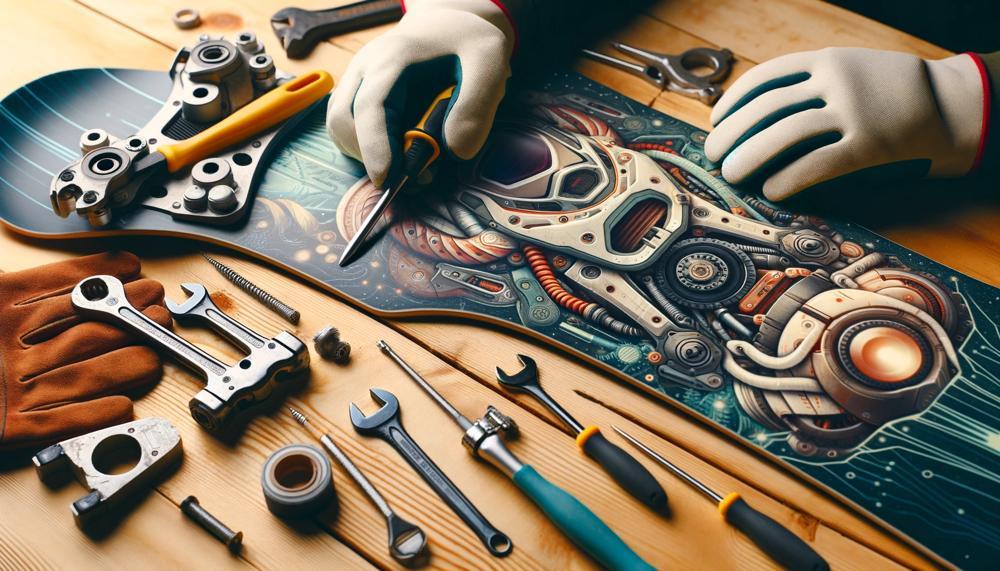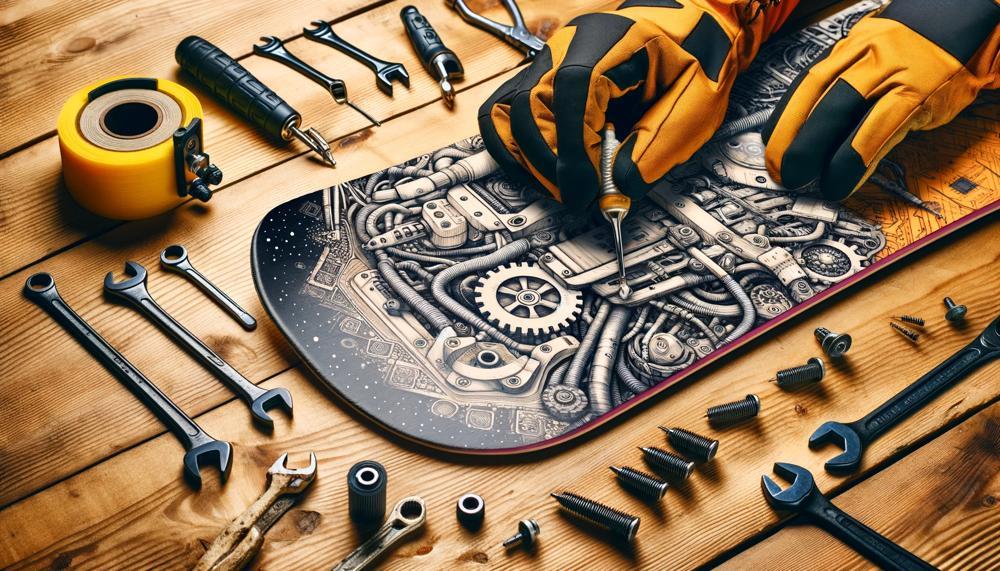Do you find yourself putting off waxing your snowboard? We understand, after a long day of shredding on the mountain, the last thing you want to do is spend time maintaining your gear. But what if we told you that neglecting to wax your snowboard could have serious consequences? Don’t believe us? Let’s take a closer look:
- Reduced speed and maneuverability: A dry and rough board can slow you down and make it difficult to turn or carve.
- Increased risk of damage: Without a protective layer of wax, your board is more vulnerable to scratches and dings from rocks and debris on the slopes.
- Decreased lifespan: Regular waxing not only improves performance but also extends the life of your snowboard by protecting its base.
- Unpredictable ride: A poorly waxed board can lead to an unpredictable and bumpy ride, making it harder to control on the mountain.
- Wasted money: Neglecting to wax your board means you’ll have to replace it sooner than expected, costing you more money in the long run.
Don’t let laziness or lack of knowledge lead to these consequences. Keep reading for expert tips on how to properly maintain your snowboard and ensure a smooth ride every time. Trust us, both your future self and wallet will thank you.
What Happens If You Don’t Wax Your Snowboard?
Contents
Neglecting to regularly wax your snowboard can have a multitude of negative consequences on its performance and longevity. These include:
- Reduced velocity: The absence of wax on your snowboard can make it feel as though it is dragging through the snow, resulting in a slower ride and less control over your speed. This is particularly noticeable on flat terrain, where wax aids in the smooth gliding of the board.
- Challenging turning and carving: The lack of wax can make turning and carving much more difficult. The board will not be as responsive to your movements, making it harder to maneuver and control on the slopes.
- Increased friction and pressure: An unwaxed snowboard puts additional strain on the base and increases friction between the board and the ground surface. This can lead to damage or wear on the base over time.
- Shortened lifespan: Failing to wax your snowboard regularly can decrease its lifespan due to increased friction and pressure causing damage to the base. Regular waxing helps protect and maintain the base for longer use.
- Difficulty maintaining speed: On low inclines, an unwaxed snowboard can get stuck, making it challenging to maintain speed. This can be frustrating and hinder your overall snowboarding experience.
- Risk of base damage: Without wax, the base of your snowboard is susceptible to scratches and other forms of damage. Regular waxing adds a protective layer that helps prevent damage from rocks, debris, and other hazards on the slopes.
Neglecting to regularly apply wax to your snowboard can result in various adverse effects that impact its performance and longevity. These include:
- Reduced speed: Without proper waxing, your snowboard may feel like it is dragging through the snow, leading to a slower ride and less control over your speed. This is especially noticeable on flat terrain where wax helps the board glide smoothly.
- Difficult turning and carving: The lack of wax can make it challenging to turn and carve on your snowboard. The board will not respond as well to your movements, making it harder to maneuver and control on the slopes.
- Increased friction and pressure: An unwaxed snowboard puts additional strain on the base and increases friction between the board and the ground surface. This can lead to damage or wear on the base over time.
- Reduced lifespan: Failing to regularly wax your snowboard can shorten its lifespan due to increased friction and pressure causing damage to the base. Regular waxing helps protect and maintain the base for longer use.
- Difficulty maintaining speed: On low inclines, an unwaxed snowboard can get stuck, making it challenging to maintain speed. This can be frustrating and hinder your overall snowboarding experience.
- Risk of base damage: Without proper waxing, the base of your snowboard is at risk for scratches and other forms of damage. Regular waxing adds a protective layer that helps prevent damage from rocks, debris, and other hazards on the slopes.
When Should You Wax Your Snowboard?
Waxing your snowboard is an essential step in maintaining its performance and durability. It allows for a smooth glide, improved turning and carving abilities, reduced friction and pressure, and better speed control. Neglecting to wax your snowboard can lead to a slower ride, difficulty in turning and carving, increased friction and pressure, shortened lifespan, and potential base damage. So, when is the recommended frequency for waxing your snowboard?
According to experts, it is best to wax your snowboard every 2-3 full days of riding on a sintered base. However, this can also depend on personal preference and the type of conditions you will be riding in. Regularly waxing your snowboard not only improves its overall performance but also protects it from potential damage.
But why is waxing your snowboard so crucial? Well, apart from enhancing its performance, it also helps maintain its appearance. By giving it a shiny, well-maintained look, you’ll surely stand out on the slopes.
However, it’s not just about the frequency of waxing; the type of wax used also plays a significant role in the performance of your snowboard. Using the right type of wax for the specific conditions you’ll be riding in can further enhance its performance.
So, make sure to take the time to wax your snowboard regularly to fully enjoy your snowboarding experience. Not only will it ensure the best performance, but it will also keep your board looking great.
How to Wax Your Snowboard: A Beginner’s Guide
When it comes to waxing your snowboard, you’ll need a few essential tools: wax, a scraper, a brush, an iron, and a base cleaner. These items can easily be found at your local snowboard shop or online. It’s important to invest in high-quality products for the best possible results.
First, gather all your materials in one place to avoid any distractions during the waxing process. Make sure to set up your workstation on a flat surface, preferably at waist height, for easier accessibility.
Next, heat up your iron to the recommended temperature for the type of wax you’re using. While waiting for the iron to heat up, clean the base of your snowboard with the base cleaner. This step is crucial as it removes any dirt or debris that may affect the waxing process.
Once the iron is hot enough, start applying the wax on the base of your snowboard. Use long and even strokes to ensure an even distribution of wax. Remember to keep the iron moving to avoid burning the base of your board.
After you’ve covered the entire base with wax, let it cool for 15-20 minutes. This allows the wax to penetrate deep into the pores of the board, ensuring maximum performance.
Once the wax has cooled down, use a scraper to remove any excess wax from the surface. Use short and firm strokes for better results. Then, use a brush to polish and buff out any remaining bits of wax.
You’ve successfully waxed your snowboard. It’s now ready for optimal performance on the slopes. Remember to regularly maintain and re-wax your board for maximum longevity and enjoyment.
What Wax Should You Use for Your Snowboard?
When it comes to waxing your snowboard, the type of wax you use can greatly impact your overall snowboarding experience. Different waxes offer unique benefits and choosing the right one can make all the difference. Popular options include Hertel Super Hot Sauce, Demon Hyper X Wax, ZUMWax RUB ON, and Swix F Universal Easy Glide.
Hertel Super Hot Sauce is a versatile option that is suitable for most snow conditions. It is also known for its ease of application, making it a popular choice among riders of all levels. Even beginners can easily apply this wax without any difficulty.
If you’re looking for a wax that adds a bit of fun to the process, Demon Hyper X Wax is a great option. This universal wax comes in different colors and scents, allowing riders to personalize their waxing experience.
For a more convenient and fast option, ZUMWax RUB ON is the ideal choice. This wax does not require an iron for application, making it perfect for quick touch-ups or for those who do not have access to an iron.

On the other hand, if you prioritize performance and speed on the slopes, Swix F Universal Easy Glide is the recommended wax for advanced riders. It is a fluorinated wax that provides excellent glide and durability.
Can You Over-Wax Your Snowboard?
| The Negative Effects of Over-Waxing Your Snowboard | Description | Solution |
| Sluggish Performance | Over-waxing can lead to a slow and difficult ride due to excessive wax buildup. | Ensure optimal performance by regularly inspecting and waxing your board every 4-5 days or as needed based on conditions. |
| Dry and White Base | Excessive waxing can cause the base to become dry and turn white, putting it at risk for damage and affecting performance. | Avoid over-waxing by following proper techniques and not applying too much wax. |
In addition to these direct effects on performance, over-waxing can also have indirect consequences such as wasting time, money, and effort. Applying too much wax means spending more time scraping off excess wax, which can be a tedious and time-consuming process. It also leads to unnecessary expenses due to using more wax than necessary.
Moreover, over-waxing can result in a buildup of gunk and dirt on your board, requiring extra effort in maintaining and cleaning your snowboard.
It is crucial to find the right balance when it comes to waxing your snowboard. While wax is necessary for optimal performance, too much of it can do more harm than good. So, how do you avoid over-waxing? Here are some tips:
- Use the appropriate amount of wax: As a general rule, apply enough wax to create a thin layer on the base of your board. Avoid using globs or thick layers of wax.
- Choose the right wax for the conditions: Different waxes are designed for specific temperatures and snow conditions. Make sure to select the appropriate wax for the conditions you will be riding in.
- Scrape off excess wax: After applying the wax, use a scraper to remove any excess wax from the base. This prevents a buildup of gunk and dirt and ensures a smooth ride.
What Other Maintenance Does Your Snowboard Need?
When it comes to your snowboard, regular waxing is just the tip of the iceberg. There are several other maintenance tasks that should be performed regularly to ensure optimal performance and longevity. These tasks include cleaning the base, checking for damage, keeping the edges sharp, and proper storage.
- Cleaning the Base: To keep your snowboard performing at its best, it’s crucial to regularly clean the base. This helps remove any dirt or debris that can negatively impact its performance. You can use a base cleaner or simply wipe it down with a damp cloth.
- Checking for Damage: Don’t overlook the importance of regularly inspecting your snowboard for any signs of damage. Cracks or scratches may seem minor, but they can greatly affect the structural integrity of your board. It’s important to address these issues immediately to prevent further damage.
- Keeping Edges Sharp: Maintaining control and stability while riding is crucial for a successful snowboarding experience. To achieve this, it’s recommended to sharpen the edges before each season and touch them up throughout the season as needed.
- Proper Storage: How you store your snowboard can also have a significant impact on its longevity. To prevent warping, always lay your board flat in a cool, dry place when not in use. Avoid leaning it against a wall or storing it in a hot or humid environment.
By consistently performing these maintenance tasks, you can ensure that your snowboard is always performing at its peak and avoid any potential issues that could impact your ride. Keep in mind that the frequency of these tasks may vary depending on factors such as snow conditions and terrain.
Therefore, it’s important to pay attention to your board’s performance and address any issues promptly.
With proper maintenance, your snowboard can last for many seasons to come.
Also Read: How Long Does A Snowboard Last?
Conclusion
In conclusion, neglecting to wax your snowboard can have serious consequences on its performance and longevity. It can result in reduced speed and maneuverability, increased risk of damage, decreased lifespan, unpredictable rides, and wasted money. Regularly waxing your snowboard is essential for optimal performance and protection against potential damage.
To properly maintain your snowboard, it is crucial not only to wax it regularly but also to clean the base, check for any damage, keep the edges sharp, and store it properly. By following these maintenance tips, you can ensure that your snowboard is always performing at its best and avoid any issues that could affect your ride.
Selecting the right type of wax for your board is also crucial in enhancing its performance. Each type of wax offers unique benefits such as versatility, ease of application, or improved speed. However, over-waxing can have negative effects such as sluggish performance and a dry base. Striking a balance is key in maintaining a smooth ride.
Don’t let laziness or lack of knowledge lead to these consequences. Take the time to properly maintain your snowboard; trust us – both your future self and wallet will thank you. Remember to regularly wax your board every 2-3 full days of riding on a sintered base using high-quality products for optimal results.






